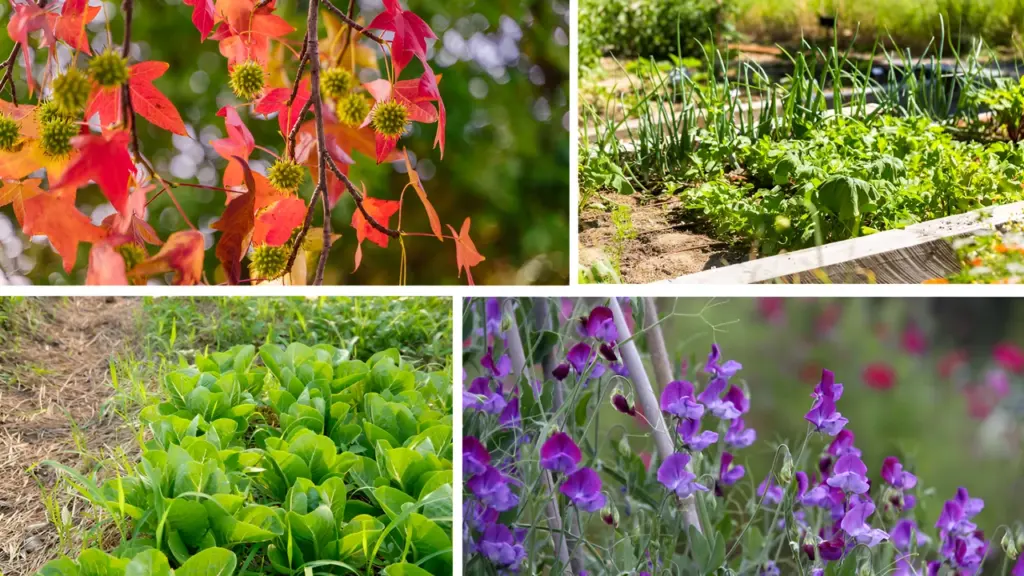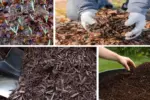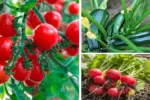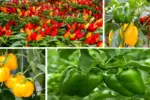Join on WhatsApp
Get the latest updates directly on WhatsApp – motivation, news & more!
As autumn ushers in cooler temperatures and shorter days, many gardeners believe it’s time to put away their tools and prepare for winter. By late September and October, the garden often begins to look a little bare, with fading flower beds and vegetable patches cleared of their summer harvests. However, what if your garden didn’t have to slow down? What if you could keep the harvests coming well into November?
Extending your gardening season beyond the traditional first frost is not only achievable but also incredibly rewarding. With a few thoughtful strategies, you can maintain a bountiful garden, rich in fresh vegetables, vibrant flowers, and lasting color throughout the fall and into the winter. Here’s how you can make the most of your outdoor space during the later months of the year.

1. Opt for Frost-Hardy Plants
The cornerstone of extending your garden season is selecting crops that are naturally suited to cool weather. Many vegetables and flowers actually thrive as the temperatures drop, offering rich flavor and lasting color.
Vegetables That Thrive in Fall:
- Kale and Collards: These hardy greens not only survive light frosts but often taste even better once kissed by cold air.
- Spinach: A fast-growing, frost-tolerant green that’s perfect for planting in late summer and harvesting into the fall.
- Root Vegetables (Carrots, Beets, Turnips): Root crops become sweeter after a frost, making them ideal for late-season harvesting.
- Radishes: These quick-growing vegetables can be harvested in just a few weeks, making them a great late-season option.
- Garlic: Planted in fall, garlic spends the winter in the ground and rewards you with a summer harvest.
Flowers for Fall Beauty:
- Pansies and Violas: Known for their bright, cheerful blooms, these flowers can withstand chilly weather.
- Mums: Classic fall flowers that bloom throughout October and into early November.
- Ornamental Kale and Cabbage: Not just for salads, these plants add texture and color to your fall garden, even when temperatures drop.
Choosing frost-resistant plants will ensure that your garden remains vibrant long after the summer crops are gone.
2. Build Season-Extending Structures
When temperatures dip, season-extending structures can provide essential protection against early frosts, creating a warmer environment for your plants.
Essential Structures:
- Row Covers: Lightweight fabric that provides frost protection while still allowing sunlight and water to reach plants. Great for greens and other cool-weather crops.
- Cold Frames: Essentially mini-greenhouses that trap daytime heat and insulate plants at night, allowing you to grow lettuce, spinach, and other crops into late fall.
- Low Tunnels/Hoop Houses: PVC or metal frames covered with plastic or fabric create a microclimate that can delay frost and extend your harvest.
- Greenhouses: For serious gardeners, a greenhouse offers nearly year-round gardening potential. Proper ventilation and insulation allow you to grow herbs, greens, and more well into the winter months.
These structures can be simple to build and don’t have to be expensive, yet they can dramatically extend your gardening season.
3. Maximize Heat Retention
Even without elaborate structures, you can employ some clever techniques to help retain heat and keep your garden warm enough for extended growing.
Simple Heat Retention Strategies:
- Mulching: A thick layer of mulch (such as straw or compost) around plants helps insulate the soil, preventing it from cooling too quickly.
- Use of Hardscaping: Materials like bricks or stones retain heat during the day and slowly release it at night, offering extra warmth to nearby plants.
- Plant Positioning: Position fall crops on the south side of fences or walls to capture reflected heat and reduce wind exposure.
- Water Jugs: Painted black water jugs placed around plants absorb heat during the day and release it at night, helping to buffer against frost.
With these simple tricks, you can create microclimates within your garden, which can make a significant difference in how long your plants thrive.
4. Succession Planting: Keep the Crops Coming
A key reason why many gardens start to look sparse in late fall is because they aren’t designed for a continuous harvest. Succession planting is a smart technique that ensures fresh crops continue to mature all the way until the first hard frost.
Succession Planting Tips:
- Late-Summer Planting: Sow seeds for fast-growing vegetables like spinach, kale, and radishes in late August or early September to ensure fall harvests.
- Staggered Sowing: Plant new seeds every 1-2 weeks to ensure that crops like lettuce, carrots, and radishes continue to mature into October and November.
- Quick Crops: Radishes and salad greens mature rapidly, making them perfect for squeezing in before colder weather fully sets in.
This strategy not only extends the harvest window but also allows your garden to phase out gradually instead of having all your crops die at once.
5. Prepare for Frost
As colder nights approach, protecting tender plants from frost becomes your priority. Even the hardiest fall vegetables can suffer damage from an unexpected frost if left unprotected.
Frost Protection Tips:
- Cover Plants at Night: Use sheets, blankets, or frost cloth to cover your plants during the night when temperatures dip. Remove covers during the day to allow sunlight to reach the plants.
- Harvest Early: Before a hard freeze, pick frost-sensitive crops like lettuce and herbs, while leaving frost-resistant vegetables like kale and carrots in place—they can often survive freezing temperatures.
- Stay Informed: Keep an eye on weather reports for frost warnings so you can act quickly to protect your garden.
A little nighttime effort can help you preserve your crops for weeks longer than if they were left unprotected.
6. Embrace Container Gardening
Containers are one of the most flexible ways to extend your garden’s lifespan. With the ability to move pots to warmer areas, you can keep growing fresh herbs, greens, and flowers well into the cooler months.
Container Gardening Benefits:
- Mobility: Potted plants can be moved to patios, porches, or even inside when temperatures drop too low.
- Heat Retention: Containers placed against sun-drenched walls or near heat-retaining structures will warm up quickly during the day and stay warm longer at night.
- Extended Harvesting: Herbs like basil, cilantro, and parsley can thrive in containers on sunny windowsills throughout the fall.
If you’re short on space or want to bring some greenery indoors, container gardening is an excellent solution.
7. Extend the Beauty of Your Flower Garden
Fall isn’t just for harvesting vegetables—flower gardens can continue to provide beauty long after the first frost with the right plant choices and creative touches.
Tips for Fall Flower Displays:
- Late-Blooming Perennials: Plants like asters, sedum, and Japanese anemones bloom well into the fall, providing bursts of color when other flowers are fading.
- Cold-Tolerant Annuals: Replace summer blooms with pansies, violas, and ornamental kale for a continued display of color.
- Fall Decor: Add pumpkins, gourds, corn stalks, and autumn wreaths to your garden to keep it looking festive even as flower blooms fade.
With the right plants and a little seasonal décor, your garden will look welcoming well into November.
8. Plan Ahead for Next Year
Not only does extending your garden season give you more time to enjoy fresh harvests, but it also helps prepare your garden for the next growing season.
Fall Gardening for Future Harvests:
- Plant Garlic and Onions: These crops thrive when planted in fall and will reward you with a summer harvest.
- Sow Cover Crops: Rye, clover, or vetch planted in the fall can help enrich the soil and prevent erosion, setting you up for a successful spring.
- Mulch Perennials: Protect perennials from the winter cold by mulching them, ensuring they come back strong in the spring.
By continuing to garden into November, you’ll not only enjoy your current crops but also set the stage for a productive spring.
9. The Mental and Health Benefits of Fall Gardening
Gardening in the cooler months isn’t just about practicality—it’s also beneficial for your mental and physical well-being.
- Outdoor Movement: Gardening is a great way to get light physical exercise, even in fall.
- Stress Relief: The act of gardening has been shown to lower stress levels, and continuing to work in the garden through the fall helps prolong these benefits.
- Connection with Nature: Watching your garden flourish through the colder months offers a sense of resilience and accomplishment.
Instead of lamenting the end of summer, embrace the beauty and benefits of fall gardening for a more fulfilling experience.
Final Thoughts
With a few smart techniques and thoughtful planning, you can keep your garden productive and beautiful well into November—and beyond. Whether you’re growing cold-hardy vegetables, protecting your crops from frost, or creating a cozy greenhouse, there are plenty of ways to extend your growing season. Your garden doesn’t have to stop when the weather turns cold—it can be a year-round source of food, color, and enjoyment.
So, grab your gardening gloves and start planning for a longer growing season—you might be surprised at what you can achieve even as the first frost approaches!




